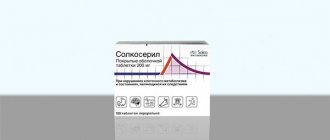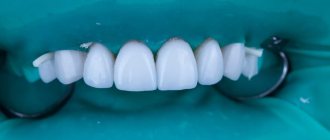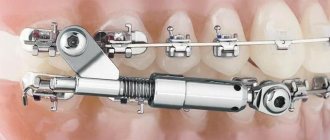Description
Capsule-shaped tablets, with a biconvex surface, film-coated, white or almost white. White in cross section.
Pharmacotherapeutic group
Antimicrobial drugs are quinolone derivatives. Fluoroquinolones.
ATS code
J01MA02
Pharmacological properties
Pharmacokinetics
When taken orally, it is quickly and fairly completely absorbed from the gastrointestinal tract (mainly in the duodenum and jejunum). Eating slows down absorption but does not change maximum concentration (Cmax) or bioavailability. Bioavailability - 50-85%, volume of distribution - 2-3.5 l/kg, binding to plasma proteins - 20-40%. The time to reach the maximum concentration (TCmax) is 60-90 minutes, the maximum concentration linearly depends on the dose taken and is 1.2, 2.4, 4.3 and 5.4 μg/ml at doses of 250, 500, 750 and 1000 mg, respectively. 12 hours after oral administration of 250, 500 and 750 mg, the concentration of the drug in plasma decreases to 0.1, 0.2 and 0.4 mcg/ml, respectively.
Well distributed in body tissues (excluding fat-rich tissue, such as nervous tissue). The concentration in tissues is 2-12 times higher than in plasma. Therapeutic concentrations are achieved in saliva, tonsils, liver, gallbladder, bile, intestines, abdominal and pelvic organs (endometrium, fallopian tubes and ovaries, uterus), seminal fluid, prostate tissue, kidneys and urinary tract, pulmonary tissue, bronchial secretions, bone tissue, muscles, synovial fluid and articular cartilage, peritoneal fluid, skin. It penetrates into the cerebrospinal fluid in a small amount, where its concentration in the absence of inflammation of the meninges is 6-10% of that in the blood serum, and in the case of inflammation - 14-37%. Ciprofloxacin also penetrates well into the ocular fluid, pleura, peritoneum, lymph, and through the placenta. The concentration of ciprofloxacin in blood neutrophils is 2-7 times higher than in blood serum.
Metabolized in the liver (15-30%) with the formation of low-active metabolites (diethylciprofloxacin, sulfociprofloxacin, oxociprofloxacin, formylciprofloxacin).
The half-life is about 4 hours, in case of chronic renal failure - up to 12 hours. It is excreted mainly by the kidneys by tubular filtration and tubular secretion in unchanged form (40-50%) and in the form of metabolites (15%), the rest - through the gastrointestinal tract. intestinal tract. A small amount is excreted in breast milk.
Renal clearance - 3-5 ml/min/kg; total clearance - 8-10 ml/min/kg.
In chronic renal failure (creatinine clearance above 20 ml/min), the percentage of the drug excreted through the kidneys decreases, but accumulation in the body does not occur due to a compensatory increase in drug metabolism and excretion through the gastrointestinal tract.
Pharmacodynamics
A broad-spectrum antimicrobial agent, a quinolone derivative, suppresses bacterial DNA gyrase (topoisomerases II and IV, responsible for the process of supercoiling of chromosomal DNA around nuclear RNA, which is necessary for reading genetic information), disrupts DNA synthesis, growth and division of bacteria; causes pronounced morphological changes (including cell wall and membranes) and rapid death of the bacterial cell.
It has a bactericidal effect on gram-negative microorganisms during the period of rest and division (since it affects not only DNA gyrase, but also causes lysis of the cell wall), on gram-positive microorganisms - only during the period of division.
Low toxicity for the cells of the macroorganism is explained by the absence of DNA gyrase in them. While taking ciprofloxacin, there is no parallel development of resistance to antibacterial drugs that do not belong to the group of gyrase inhibitors, which makes it effective against bacteria that are resistant, for example, to aminoglycosides, penicillins, cephalosporins, tetracyclines.
Gram-negative aerobic bacteria are sensitive to ciprofloxacin: enterobacteria (Escherichia coli, Salmonella spp., Shigella spp., Citrobacter spp., Klebsiella spp., Enterobacter spp., Proteus mirabilis, Proteus vulgaris, Serratia marcescens, Hafnia alvei, Edwardsiella tarda, Providencia spp. , Morganella morganii, Vibrio spp., Yersinia spp.), other gram-negative bacteria (Haemophilus spp., Pseudomonas aeruginosa, Moraxella catarrhalis, Aeromonas spp., Pasteurella multocida, Plesiomonas shigelloides, Campylobacter jejuni, Neisseria spp.); some intracellular pathogens: Legionella pneumophila, Brucella spp., Listeria monocytogenes, Mycobacterium tuberculosis, Mycobacterium kansasii.
Gram-positive aerobic bacteria are also sensitive to ciprofloxacin: Staphylococcus spp. (Staphylococcus aureus, Staphylococcus haemolyticus, Staphylococcus hominis, Staphylococcus saprophyticus), Streptococcus spp. (Streptococcus pyogenes, Streptococcus agalactiae).
Active against Bacillus anthracis.
Most staphylococci resistant to methicillin are also resistant to ciprofloxacin. The sensitivity of Streptococcus pneumoniae, Enterococcus faecalis, Mycobacterium avium (located intracellularly) is moderate (high concentrations are required to suppress them).
The following are resistant to the drug: Bacteroides fragilis, Pseudomonas cepacia, Pseudomonas maltophilia, Ureaplasma urealyticum, Clostridium difficile, Nocardia asteroides. Not effective against Treponema pallidum.
Resistance develops extremely slowly, since, on the one hand, after the action of ciprofloxacin there are practically no persistent microorganisms left, and on the other hand, bacterial cells do not have enzymes that inactivate it.
Description of the drug CIPROFLOXACIN for systemic use
When treating severe infections, staphylococcal infections and infections caused by anaerobic bacteria, ciprofloxacin should be used in combination with appropriate antibacterial agents.
Ciprofloxacin is not recommended for the treatment of infections caused by Streptococcus pneumoniae due to its limited effectiveness against the pathogen.
For genital infections suspected of being caused by strains of Neisseria gonorrhoeae resistant to fluoroquinolones, information about local resistance to ciprofloxacin should be taken into account and the sensitivity of the pathogen should be confirmed by laboratory tests.
Resistance to fluoroquinolones in Escherichia coli, the most common pathogen causing urinary tract infections, varies depending on the region of the Russian Federation. When prescribing, it is recommended to take into account the local prevalence of Escherichia coli resistance to fluoroquinolones.
Ciprofloxacin has an effect on prolonging the QT interval. Given that women have a longer average QT interval compared to men, they are more sensitive to drugs that cause QT prolongation. Elderly patients also have increased sensitivity to the effects of drugs that prolong the QT interval. Use ciprofloxacin with caution in combination with drugs that prolong the QT interval (e.g., Class IA and III antiarrhythmics, tricyclic antidepressants, macrolides, and antipsychotics) or in patients at increased risk for QT prolongation or QT syndrome (e.g., congenital long QT syndrome). QT interval, corrected electrolyte imbalances such as hypokalemia or hypomagnesemia, and heart disease such as heart failure, myocardial infarction, bradycardia).
Sometimes, after taking the first dose of ciprofloxacin, hypersensitivity reactions may develop, incl. allergic reactions. In rare cases, after the first use, anaphylactic reactions up to anaphylactic shock may occur. In these cases, the use of ciprofloxacin should be stopped immediately and appropriate treatment should be instituted.
If severe and prolonged diarrhea occurs during or after treatment with ciprofloxacin, the diagnosis of pseudomembranous colitis should be excluded, which requires immediate discontinuation of the drug and the appointment of appropriate treatment (vancomycin orally at a dose of 250 mg 4 times a day). In this situation, the use of drugs that suppress intestinal motility is contraindicated.
Cases of liver necrosis and life-threatening liver failure have been reported with the use of ciprofloxacin. If you have any of the following signs of liver disease, such as anorexia, jaundice, dark urine, itching, or a painful abdomen, you should stop taking ciprofloxacin. Patients taking ciprofloxacin with a history of liver disease may experience a transient increase in liver transaminases and alkaline phosphatase or cholestatic jaundice.
In patients with myasthenia gravis, ciprofloxacin should be used with caution, because possible exacerbation of symptoms.
At the first signs of tendinitis (painful swelling in the joint area, inflammation), the use of ciprofloxacin should be stopped and physical activity should be avoided, because There is a risk of tendon rupture, and consult a doctor. When taking ciprofloxacin, cases of tendinitis and tendon rupture (mainly the Achilles tendon), sometimes bilaterally, may occur within the first 48 hours after the start of therapy. Inflammation and rupture of the tendon may occur even several months after stopping treatment with ciprofloxacin. Elderly patients, patients with renal failure, and organ transplant patients concomitantly receiving corticosteroid treatment have an increased risk of tendinopathy. Ciprofloxacin should be used with caution in patients with a history of tendon diseases associated with quinolones.
Ciprofloxacin, like other fluoroquinolones, can provoke seizures and lower the seizure threshold. In patients with epilepsy and a history of central nervous system diseases (for example, a decrease in the seizure threshold, a history of seizures, cerebrovascular accidents, organic brain lesions or stroke) due to the risk of developing adverse reactions from the central nervous system, ciprofloxacin should be used only in cases when the expected clinical effect outweighs the possible risk of side effects. If seizures occur, use of ciprofloxacin should be discontinued.
Psychiatric reactions may occur even after the first use of fluoroquinolones, including ciprofloxacin. In rare cases, depression or psychotic reactions can progress to suicidal thoughts and suicide attempts, incl. completed. In case of development of any side effects from the central nervous system, including mental disorders, ciprofloxacin should be immediately discontinued and appropriate therapy should be started. In these cases, it is recommended to switch to therapy with an antibiotic other than a fluoroquinolone, if possible.
Cases of sensory or sensorimotor polyneuropathy, hypoesthesia, dysesthesia, or weakness have been reported in patients taking fluoroquinolones, including ciprofloxacin. If symptoms such as pain, burning, tingling, numbness, or weakness occur, patients should inform their doctor before continuing to use the drug.
Photosensitivity reactions may occur when taking ciprofloxacin, so patients should avoid contact with direct sunlight and UV light. Treatment should be discontinued if symptoms of photosensitivity are observed (for example, changes in the skin reminiscent of sunburn).
It is known that ciprofloxacin is a moderate inhibitor of CYP1A2 isoenzymes. Caution should be exercised when simultaneous use of ciprofloxacin and drugs metabolized by these enzymes, such as theophylline, methylxanthine, caffeine, duloxetine, ropinirole, clozapine, olanzapine, agomelatine, because An increase in the concentration of these drugs in the blood serum, due to inhibition of their metabolism by ciprofloxacin, may cause specific adverse reactions. The simultaneous use of ciprofloxacin and tizanidine is contraindicated.
To avoid the development of crystalluria, it is unacceptable to exceed the recommended daily dose; sufficient fluid intake and maintaining an acidic urine reaction are also necessary.
In vitro, ciprofloxacin may interfere with the bacteriological study of Mycobacterium tuberculosis, inhibiting its growth, which can lead to false negative results when diagnosing this pathogen in patients taking ciprofloxacin.
As with other fluoroquinolones, changes in blood glucose concentrations, including hypo- and hyperglycemia, are possible when using ciprofloxacin. During therapy with ciprofloxacin, dysglycemia may occur more often in elderly patients and patients with diabetes mellitus receiving concomitant therapy with oral hypoglycemic drugs (for example, sulfonylureas) or insulin. When using ciprofloxacin in such patients, the risk of developing hypoglycemia, including hypoglycemic coma, increases. It is necessary to inform patients about the symptoms of hypoglycemia (confusion, dizziness, increased appetite, headache, nervousness, palpitations or increased pulse rate, pale skin, perspiration, trembling, weakness). If the patient develops hypoglycemia, treatment with ciprofloxacin should be stopped immediately and appropriate therapy should be initiated. In these cases, it is recommended to switch to therapy with an antibiotic other than a fluoroquinolone, if possible. When treating with ciprofloxacin in elderly patients and patients with diabetes mellitus, careful monitoring of blood glucose concentrations is recommended.
Epidemiological studies have reported an increased risk of aortic aneurysm and aortic dissection after taking fluoroquinolones, especially in elderly patients.
Therefore, fluoroquinolones should be used only after careful benefit/risk assessment and consideration of other treatment options in patients with a family history of aortic aneurysm or in patients with a known aortic aneurysm and/or aortic dissection or in the presence of other risk factors or conditions predisposing to the development of aortic aneurysm or aortic dissection (for example, Marfan syndrome, vascular Ehlers-Danlos syndrome, Takayasu arteritis, giant cell arteritis, Behçet's disease, hypertension, atherosclerosis).
In case of sudden pain in the abdomen, chest, or back, patients should immediately consult a doctor at the emergency room.
Impact on the ability to drive vehicles and machinery
Fluoroquinolones, including ciprofloxacin, may impair the ability of patients to drive a car and engage in other potentially hazardous activities that require increased attention and speed of psychomotor reactions due to their effect on the central nervous system.
Indications for use
Infectious and inflammatory diseases caused by sensitive microorganisms:
lower respiratory tract infections (acute bronchitis and chronic bronchitis in the acute stage, pneumonia, bronchiectasis, infectious complications of cystic fibrosis); ENT infections (acute sinusitis); kidney and urinary tract infections (cystitis, pyelonephritis); complicated intra-abdominal infections (in combination with metronidazole); chronic bacterial prostatitis; uncomplicated gonorrhea; typhoid fever, campylobacteriosis, shigellosis, traveler's diarrhea; infections of the skin and soft tissues (infected ulcers, wounds, burns, abscesses, phlegmon); infections of bones and joints (osteomyelitis, septic arthritis); infections due to immunodeficiency (occurring during treatment with immunosuppressive drugs or in patients with neutropenia); prevention and treatment of pulmonary anthrax;
Children:
prevention and treatment of pulmonary anthrax (infection with Bacillus anthracis) from 6 years of age.
Directions for use and doses
Inside. The tablets should be swallowed whole with a small amount of liquid after meals. When taking the tablet on an empty stomach, the active substance is absorbed faster.
- For mild and moderate lower respiratory tract infections - 0.5 g 2 times a day, for severe infections - 0.75 g 2 times. The course of treatment is 7-14 days.
- For acute sinusitis - 0.5 g 2 times a day. The course of treatment is 10 days.
- For mild to moderate skin and soft tissue infections - 0.5 g 2 times a day, for severe infections - 0.75 g 2 times. The course of treatment is 7-14 days.
- For infections of bones and joints - mild and moderate - 0.5 g 2 times a day, for severe infections - 0.75 g 2 times. The course of treatment is up to 4-6 weeks.
- For uncomplicated urinary tract infections - 0.25-0.5 g 2 times a day; course of treatment - 7-14 days, for complicated urinary tract infections 0.5 g every 12 hours for 7-14 days.
- For chronic prostatitis - 0.5 g 2 times, course of treatment - 28 days.
- For uncomplicated gonorrhea - 0.25 g once.
- Acute intestinal infections with severe course (salmonellosis, shigellosis, campylobacteriosis, etc.) - 0.5 g 2 times, course of treatment - 5-7 days.
- For typhoid fever - 0.5 g 2 times; course of treatment - 10 days.
- For complicated intra-abdominal infections - 0.5 g every 12 hours for 7-14 days.
- For the prevention and treatment of pulmonary anthrax - 0.5 g 2 times a day for 60 days.
- In patients with immunodeficiency, treatment is prescribed depending on the severity of the infection and the type of pathogen. Therapy is carried out throughout the entire period of neutropenia.
- Chronic renal failure: when creatinine clearance (CC) is more than 50 ml/min, no dose adjustment is required; with CC 30-50 ml/min - 0.25-0.5 every 12 hours; with CC 5-29 ml/min - 0.25-0.5 g every 18 hours. If the patient is undergoing hemodialysis or peritoneal dialysis - 0.25-0.5 g/day, the drug should be taken after the hemodialysis session.
- In pediatrics: for
pulmonary anthrax (prevention and treatment) - 15 mg/kg 2 times a day. The maximum single dose is 0.5 g, the daily dose is 1 g. The total duration of taking ciprofloxacin is 60 days.
Side effects
anorexia, nausea, vomiting, abdominal pain, flatulence, diarrhea, cholestatic jaundice (especially in patients with previous liver diseases), hepatitis, hepatonecrosis; dizziness, headache, increased fatigue, anxiety, tremor, insomnia, nightmares, peripheral paralgesia (anomaly in the perception of pain), sweating, increased intracranial pressure, confusion, depression, hallucinations, as well as other manifestations of psychotic reactions (rarely progressing to conditions in which the patient may harm himself).
Rarely:
migraine, fainting, thrombosis of cerebral arteries; disturbances of taste and smell, visual disturbances (diplopia, changes in color vision), tinnitus, hearing loss; tachycardia, heart rhythm disturbances, prolongation of the QT interval, decreased blood pressure; leukopenia, granulocytopenia, anemia, thrombocytopenia, leukocytosis, thrombocytosis, hemolytic anemia; hypoprothrombinemia, increased activity of liver transaminases and alkaline phosphatase, hypercreatininemia, hyperbilirubinemia, hyperglycemia; hematuria, crystalluria (primarily with alkaline urine and low diuresis), glomerulonephritis, dysuria, polyuria, urinary retention, albuminuria, urethral bleeding, decreased nitrogen excretory function of the kidneys, interstitial nephritis; pruritus, urticaria, blistering accompanied by bleeding and the appearance of small nodules that form scabs, drug fever, pinpoint hemorrhages on the skin (petechiae), swelling of the face or larynx, shortness of breath, eosinophilia, vasculitis, erythema nodosum, exudative erythema multiforme, Stevens syndrome -Johnson (malignant exudative erythema), toxic epidermal necrolysis (Lyell's syndrome); arthralgia, arthritis, tendovaginitis, tendon ruptures, myalgia; general weakness, increased photosensitivity, superinfections (candidiasis, pseudomembranous colitis), “flushes” of blood to the face.
Contraindications
hypersensitivity to ciprofloxacin, other fluoroquinolones, auxiliary components of the drug; simultaneous use with tizanidine (risk of a pronounced decrease in blood pressure, drowsiness); childhood and adolescence up to 18 years of age (until the process of skeletal formation is completed), prevention and treatment of pulmonary anthrax - children up to 6 years of age; pregnancy and lactation; tendon damage due to previous treatment with fluoroquinolones; tendon lesions, including tenosynovitis, tendon rupture, muscle lesions (rhabdomyolysis); pseudomembranous colitis.
Pharmacological properties
Ciprfloxacin solution is an antimicrobial agent with a broad spectrum of action. The antibiotic included in its composition is a fluoroquinolone derivative. Its action is based on the mechanism of suppression of bacterial DNA gyrase and disruption of DNA synthesis, affecting the growth and division of bacterial microflora, which causes the rapid death of bacterial cells.
The use of ciprofloxacin does not cause resistance to other actibiotics: aminoglycosides, penicillins, tetracyclines, cephalosporins, etc. Most gram-positive and gram-negative aerobic bacteria are sensitive to ciprofloxacin. Resistant to the drug: Pseudomonas cepacia, Bacteroides fragilis, Pseudomonas maltophilia, Clostridium difficile Nocardia asteroides, Ureaplasma urealyticum. It is ineffective against Treponema pallidum.
Drug interactions
Due to a decrease in the activity of microsomal oxidation processes in hepatocytes, it increases the concentration and lengthens the half-life of theophylline (and other xanthines, such as caffeine), oral hypoglycemic drugs, and indirect anticoagulants.
When combined with other antimicrobial drugs (beta-lactam antibiotics, aminoglycosides, clindamycin, metronidazole), synergism is usually observed; can be successfully used in combination with azlocillin and ceftazidime for infections caused by Pseudomonas spp.; with mezlocillin, azlocillin and other beta-lactam antibiotics - for streptococcal infections; with isoxazolylpenicillins and vancomycin - for staphylococcal infections; with metronidazole and clindamycin - for anaerobic infections.
It enhances the nephrotoxic effect of cyclosporine, there is an increase in serum creatinine; in such patients it is necessary to monitor this indicator 2 times a week.
When taken simultaneously, it enhances the effect of indirect anticoagulants and helps reduce the prothrombin index.
Oral administration together with iron-containing drugs, sucralfate and antacid drugs containing magnesium, calcium and aluminum salts leads to decreased absorption of ciprofloxacin, so it should be prescribed 1-2 hours before or 4 hours after taking the above drugs.
Non-steroidal anti-inflammatory drugs (excluding acetylsalicylic acid) increase the risk of developing seizures.
Fluoroquinolones form chelate compounds with magnesium and aluminum ions contained in the dosage form of didanosine, which sharply reduces the absorption of fluoroquinolone, so ciprofloxacin is taken 2 hours before taking didanosine or 2 hours after taking this drug.
Metoclopramide accelerates absorption, which leads to a decrease in the time to reach its maximum concentration in the blood plasma.
Co-administration of uricosuric drugs leads to a slower elimination (up to 50%) and an increase in plasma concentrations of ciprofloxacin.
Increases the maximum concentration by 7 times (from 4 to 21 times) and the area under the concentration-time curve by 10 times (from 6 to 24 times) of tizanidine, which increases the risk of a pronounced decrease in blood pressure and drowsiness.
CIPROFLOXACIN
Interaction
Drugs known to prolong the QT Caution
should be exercised when ciprofloxacin (as well as other fluoroquinolones) is used concomitantly in patients receiving drugs known to prolong the QT interval (eg, class IA and III antiarrhythmics, tricyclic antidepressants, macrolides, antipsychotics, see section "Special instructions"),
Theophylline
The simultaneous use of ciprofloxacin and drugs containing theophylline may cause an undesirable increase in the concentration of theophylline in the blood plasma and, accordingly, the occurrence of theophylline-induced adverse events: in very rare cases, these adverse events can be life-threatening for the patient. If the simultaneous use of these two drugs is unavoidable, it is recommended to constantly monitor the concentration of theophylline in the blood plasma and, if necessary, reduce the dose of theophylline (see section "Special instructions", cytochrome P450).
Other xanthine derivatives
The simultaneous use of ciprofloxacip and caffeine or pentoxifylline (oxpentifylline) may lead to an increase in the concentration of xanthine derivatives in the blood serum.
Tizanidine
With the simultaneous use of ciprofloxacip and drugs containing tizanidine, an increase in the concentration of tizanidine in the blood serum was detected: an increase in the maximum concentration (Cmax) by 7 (from 4 to 21) times, an increase in the AUC (area under the pharmacokinetic curve “side effect”). Careful monitoring of blood glucose levels is necessary.
Probenecid
Probenecid slows down the rate of excretion of ciprofloxacin by the kidneys. The simultaneous use of ciprofloxacin and drugs containing probenecid leads to an increase in the concentration of ciprofloxacin in the blood plasma.
Phenytoin
With the simultaneous use of ciprofloxacin and phenytoin, a change (increase or decrease) in the content of phenytoin in the blood plasma was observed. To avoid weakening of the anticonvulsant effect of phenytoin due to a decrease in its concentration, as well as to prevent adverse events associated with phenytoin overdose when stopping ciprofloxacin, it is recommended to monitor phenytoin therapy in patients, including determination of phenytoin levels in the blood plasma during the entire period of simultaneous use of both drugs and for a short time after completion of combination therapy.
Methotrexate
With the simultaneous use of methotrexate and ciprofloxacin, the renal tubular transport of methotrexate may slow down, which may be accompanied by an increase in the concentration of methotrexate in the blood plasma and the likelihood of developing side effects of methotrexate. In this regard, patients receiving concomitant therapy with methotrexate and ciprofloxacin should be closely monitored.
Omeprazole
With the combined use of ciprofloxacin and drugs containing omeprazole, there may be a slight decrease in the maximum concentration of ciprofloxacin in plasma and a decrease in the area under the pharmacokinetic curve (conSpecial instructions, cytochrome P450).
Clozapine
Concomitant use of clozapine and ciprofloxacin may increase serum concentrations of clozapine and N-desmethylclozapine. The patient's condition should be monitored and, if necessary, the dosage regimen of clozapine should be adjusted during its combined use with ciprofloxacin and for a short time after completion of combination therapy (see section "Special Instructions", cytochrome P450).
Sildenafil
With the simultaneous use of ciprofloxacin and sildenafil, the Cmax and AUC of sildenafil may increase by 2 times. In this regard, the use of this combination is possible only after assessing the benefit/risk ratio.
Vitamin K antagonists (warfarin, acenocoumarol, phenprocoumon, fluindone)
The combined use of ciprofloxacin and vitamin K antagonists may lead to an increase in their anticoagulant effect. The magnitude of this effect may vary depending on concomitant infections, age and general condition of the patient. The INR should be monitored during concomitant use of ciprofloxacin and vitamin K antagonists and for a short time after completion of combination therapy.
Cation-containing drugs
Simultaneous use of ciprofloxacin and cation-containing drugs; mineral supplements containing calcium, magnesium, aluminum, iron; sucralfate, antacids, polymeric phosphate compounds (for example, sevelamer, lanthanum carbonate) and drugs with a large buffer capacity (for example, didanosine tablets) containing magnesium, aluminum or calcium, reduce the absorption of ciprofloxacin. In such cases, ciprofloxacin should be taken either 1-2 hours before or 4 hours after taking these drugs.
Eating food and dairy products
The simultaneous use of ciprofloxacin and dairy products or drinks fortified with minerals (for example, milk, yogurt, calcium-fortified juices) should be avoided as the absorption of ciprofloxacin may be reduced. Calcium contained in regular food does not significantly affect the absorption of ciprofloxacin.
special instructions
Ciprofloxacin is not the drug of choice for suspected or established pneumonia caused by Streptococcus pneumoniae.
To avoid the development of crystalluria, it is unacceptable to exceed the recommended daily dose; sufficient fluid intake and maintaining an acidic urine reaction are also necessary.
Patients with epilepsy, a history of seizures, vascular diseases and organic brain damage due to the threat of adverse reactions from the central nervous system should be prescribed ciprofloxacin only for “vital” indications.
If severe and prolonged diarrhea occurs during or after treatment with ciprofloxacin, the diagnosis of pseudomembranous colitis should be excluded, which requires immediate discontinuation of the drug and the appointment of appropriate treatment.
If pain occurs in the tendons or when the first signs of tenosynovitis appear, treatment should be stopped due to the fact that isolated cases of inflammation and even tendon rupture have been described during treatment with fluoroquinolones.
During treatment with ciprofloxacin, UV radiation (including contact with direct sunlight) should be avoided.
Features of the effect of the drug on the ability to drive a vehicle or other potentially dangerous mechanisms.
During treatment, you should refrain from engaging in potentially hazardous activities that require increased attention and speed of mental and motor reactions.
Instructions for use CIPROFLOXACIN
Severe infectious diseases and mixed infectious processes caused by gram-positive and anaerobic flora
Monotherapy with ciprofloxacin is not suitable for the treatment of severe infections and diseases that may be caused by gram-positive or anaerobic pathogenic flora. In these cases, ciprofloxacin should be prescribed simultaneously with other antibacterial drugs.
Streptococcal infection (including Streptococcus pneumoniae)
Ciprofloxacin is not recommended for the treatment of streptococcal infections due to lack of effectiveness.
Urogenital infections
Epididymo-orchitis and pelvic diseases can be caused by fluoroquinolone-resistant Neisseria gonorrhoeae. Ciprofloxacin should be co-administered with other antibacterial drugs, unless ciprofloxacin-resistant Neisseria gonorrhoeae can be excluded. If clinical improvement is not observed within 3 days, then treatment should be reconsidered.
Intraperitoneal infectious diseases
There is limited data on the effectiveness of ciprofloxacin for the treatment of postoperative intraperitoneal infections.
Traveler's diarrhea
When choosing ciprofloxacin, it is necessary to take into account information about drug resistance of the relevant pathogenic microorganism in the country being visited.
Infectious diseases of bones and joints
Ciprofloxacin should be prescribed in combination with other antimicrobial drugs and only after a microbiological study.
anthrax
Use in humans is based on in vitro susceptibility studies and animal studies. Information on the use of the drug in humans is limited. The doctor should be guided by national and/or international documents related to the treatment of this disease.
Children and teenagers
Treatment can only be prescribed by a specialist experienced in the treatment of cystic fibrosis and/or severe infectious diseases in children and adolescents. Safety data obtained from randomized, double-blind studies of ciprofloxacin in children have identified cases of possible drug-related arthropathy (identified by clinical signs and symptoms). Treatment should be started only after assessing the benefit/risk ratio, as joint-related adverse reactions may occur.
Bronchopulmonary infectious diseases
Clinical studies included children and adolescents aged 5-17 years. There are limited data regarding the treatment of children aged 1 to 5 years.
Complicated urinary tract infections and pyelonephritis
Clinical studies included children and adolescents aged 1 to 17 years. Treatment with ciprofloxacin should be considered in cases where treatment with other drugs is not possible, and only after microbiological analysis.
Other specific severe infectious diseases
Ciprofloxacin is used in the treatment of other serious infectious diseases according to official guidelines or after a careful assessment of the benefit/risk ratio in cases where other treatment is not possible or after an unfavorable outcome of conventional treatment, and only after microbiological analysis.
Hypersensitivity
After taking a single dose of the drug, hypersensitivity reactions may occur, including anaphylactic and anaphylactoid reactions. If these reactions occur, it is necessary to stop taking the drug and prescribe appropriate conservative treatment.
Musculoskeletal system
Ciprofloxacin should not be used in patients with a history of tendon disease or quinolone-related disorders. However, in rare cases, Ciprofloxacin may be prescribed to such patients for the treatment of certain severe infectious diseases after microbiological confirmation of the causative agent and assessment of the risk/benefit ratio. Because there have been isolated cases of tendinitis or tendon rupture during treatment with fluoroquinolones (primarily in elderly patients or in patients concomitantly taking corticosteroids), if any signs of this disease, for example, painful swelling or inflammation, the drug should be discontinued and immobilize the affected limb. Ciprofloxacin should also be used with caution in patients with myasthenia gravis.
Photosensitivity
Ciprofloxacin has been shown to cause photosensitivity reactions. Patients taking Ciprofloxacin should avoid direct exposure to sunlight and UV radiation.
CNS
It is known that quinolones can initiate seizures and lower the seizure threshold. Ciprofloxacin should be used with caution in patients with diseases of the central nervous system that provoke seizures, and if these phenomena occur, the drug should be discontinued.
Cases of polyneuropathy (based on neurological symptoms such as pain, burning, agitation, muscle weakness) have been reported in patients receiving ciprofloxacin. If symptoms of this disease occur, including pain, burning, tinnitus, numbness and/or weakness, the drug should be discontinued to prevent the development of an irreversible condition.
The cardiovascular system
Since the use of ciprofloxacin has been associated with cases of QT prolongation, caution should be exercised when treating patients at risk of developing TdP.
Caution should be exercised when using fluoroquinolones, including Ciprofloxacin, in patients with known risk factors for QT prolongation:
- congenital long QT interval syndrome;
- concomitant use of drugs that are known to prolong the QT interval (for example, class IA and III antiarrhythmic drugs, tricyclic antidepressants, macrolides, antipsychotics);
- electrolyte disturbances, especially uncorrected hypokalemia, hypomagnesemia;
- women and elderly patients are more sensitive to the effects of drugs that prolong the QT interval, such as Ciprofloxacin, so special caution is required;
- heart disease (for example, heart failure, myocardial infarction, bradycardia).
Gastrointestinal tract
The presence of severe and persistent diarrhea during or after treatment with the drug (including several weeks after treatment) may indicate pseudomembranous colitis (life-threatening, possibly fatal), requiring immediate treatment. In such cases, ciprofloxacin should be immediately discontinued and appropriate treatment initiated. The use of antiperistaltic drugs in this situation is contraindicated.
Renal and urinary system
During treatment with ciprofloxacin, to avoid the development of crystalluria, it is necessary to ensure that the patient receives a sufficient amount of fluid.
Hepatobiliary system
Cases of liver necrosis and life-threatening liver failure associated with the use of ciprofloxacin have been reported. If any signs or symptoms of liver disease (such as anorexia, jaundice, dark urine, itching or a tense abdomen) appear, treatment with the drug should be stopped.
Glucose-6-phosphate dehydrogenase deficiency
In patients with glucose-6-phosphate dehydrogenase deficiency, the use of ciprofloxacin may cause hemolytic reactions. It is necessary to avoid prescribing the drug to such patients, except in cases where the potential benefit outweighs the possible risk. In this case, the potential for hemolysis should be monitored.
Resistance
During long-term therapy and in cases of treatment of nosocomial infections and/or infections caused by Staphylococcus and Pseudomonas, there may be a potential risk of isolation of ciprofloxacin-resistant bacteria.
Cytochrome P450
Ciprofloxacin inhibits CYP1A2, thereby causing an increase in serum concentrations of drugs metabolized by this enzyme (for example, theophylline, clozapine, ropinirole, tizanidine). Patients taking these drugs concomitantly with ciprofloxacin should be monitored for clinical signs of overdose.
Tests
When assessing the results of bacteriological tests, the in vitro activity of ciprofloxacin against Mycobacterium tuberculosis should be taken into account.
Impact on the ability to drive vehicles and operate machinery
Ciprofloxacin may affect the patient's reaction speed, as a result of which the ability to drive a car or engage in other activities that require increased attention and speed of psychomotor reactions may be impaired.
Release form and packaging
10 tablets with a dosage of 250 mg or 5 tablets with a dosage of 500 mg are placed in a blister pack made of polyvinyl chloride film and printed varnished aluminum foil (PVC/Al) or soft aluminum foil and hard aluminum foil (Al/Al).
1 or 2 blister packs with a dosage of 250 mg or 2 blister packs with a dosage of 500 mg, together with instructions for medical use in the state and Russian languages, are placed in a cardboard pack.





